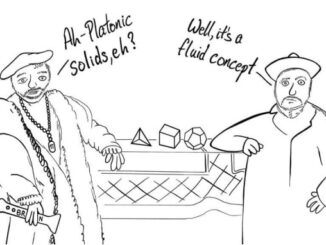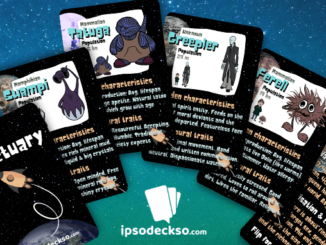
When you are playing (in) a game you are actually interacting with a system. Understanding how the system is working is the basic nature of System Thinking. So, a player is a natural Systems Thinker. However, the relationship between Systems Thinking and Game Design is much more sophisticated because the designer has to create a brand new system that should be logical, rational and also easily understandable by the players. That’s why thinking of a new game like a new system is a pretty common exercise among game designers.
The goal of this article is to explore how these two lenses (System Thinking and Game Design) can work together.

Instead of a tedious lecture to explain how this connection works, I thought to use a technique from ancient Greece which was also commonly used in the Renaissance period; the dialogue. In a dialogue the author invents a conversation between people who have knowledge, but different perspectives, around a specific topic that he wants to explore. In this way he could present different views, objections and responses, performing a true exploration of the subject. Just to give an example the “Dialogo sopra i due massimi sistemi del mondo” is the book where Galileo Galilei presented his disruptive vision of the universe.
Clearly, we are not here to discuss such an important topic, but we can imagine a dialogue between a Game Designer named GorDon (GD) and a System Thinker named STephanie (ST), and listen to their conversation about the creation of a brand new game, while trying to understand the different roles in this process.
NOTE. To distinguish the different speakers we are going to mark each comment using their references (GD or ST). I have highlighted, in bold, the unique contributions to the conversations coming from the different speakers.

GD: Good afternoon Stephanie and thanks for accepting my invitation to spend this warm day in the Italian Gardens of Hyde Park taking about a new game I am thinking of.
ST: You are welcome Gordon. It is a pleasure to listen to you while you think of a new game, to give some contributions, and at the same time, enjoy this wonderful place and weather.
GD: That’s true Stephanie, we can walk while talking.
I was asked to create a new game for the leaders of a big Company, to explore the advantages of scaling processes across large enterprises. I have identified some requirements of this game but I am a little bit stuck on the mechanic.
ST: Let’s start with the boundary conditions of this system, what are your requirements?
GD: The subject of the game is scaling, and the game should be (obviously) scalable and eventually involve a large number of players. Let’s assume we have 100 players. It should be a sort of icebreaker to prepare people around scaling and synchronicity across the organisation. Players should be leaders of business units of a large organisation who have some anti-patterns while collaborating.
ST: What are the interactions among the different parts of the systems (players, components…)?
GD: We need to define these, but ideally, as an icebreaker, should be easy to play like the Rock-Paper-Scissors game (later RPS) and easily scalable like Bingo.

ST: Let’s explore the RPS game and try to clearly understand this system, and let’s also use a mathematical perspective . This game is perfectly balanced for very specific attributes (conservative, essentially polyadic, strongly fair, and nondegenerate). Let me summarise the effect of these attributes on the new game:
- First each element should have that same number of winning and losing cases. This requirement implies the number of elements should be odd (3, 5, 7…).
- Second if you want to scale the RPS game you need to manage an exponential number of combinations (3→9, 5→25, 7→49); this could create situations not easily manageable with large number of players (100→10000)
GD: That’s an interesting, and challenging, starting point but something we can start from.
To simplify the process of collecting the choices we can use cards (instead of players’ fingers/hands), but clearly we need to define a different interaction model also because, as described in the linked RPS article, apparently the position of the player is relevant, and this is not feasible in the situation we want to create.
ST: Sometime, in Nature, when groups of individuals are interacting with each other, you can consider the clusters of individuals that have something in common. The model assumes that this “something” must be relevant for the interaction: we can call this a “role” and when a role is clear, we can model the interaction among clusters instead of individuals.. For example, people in organisations and Business Unit organisation.

GD: So we can cluster all players’ choices (read collect cards in decks) by similarities and see the results. But again scaling is too complicated and also where is the fun to draw a card if we miss the goal?
ST: We need to add some strategy. This could lead to a goal and also to a reason to take a decision to pick a different card and lead to win the game. The original RPS doesn’t have any strategy (randomness is not a strategy), but each system should have a goal. Again, we can use Nature as a reference: when you have some consumable resources you need a strategy to keep or collect resources.
GD: We have cards that can be consumed in some way and everyone is starting with the same set of cards. Maybe we can use double sided cards where the choice on one side could influence resources on the other side, so we could create different combinations of front and reverse sides where the players could pick (and consume) one of the possibilities, defining their own strategy on future actions. Each player can follow/predict different strategies so we have differentiation.
ST: That’s a great idea! In this way we could also override the limitation of the odd number of combinations, because we could create combination of the front/reverse excluding repetitions: ideally we could create a mechanic with four elements where, for each of then, you can have the other three elements, on the reverse side.
GD: That’s trivial to achieve. We can have a “called element” that is the attribute to play a card (front side) and use the elements on the reverse side (”hidden element”) to cluster cards and collect combinations. So you have the called element as a consumable resource and the hidden element to apply a strategy for future choice. Given that back and front could be identical, you can have a lot of different combinations and so apply different strategies.
We can create a game mechanic with four elements, where four is a very common number in Business Strategy. For example we could use the Plan, Do, Check, Act (PDCA) cycle that is very related to many processes of innovative organisations. In this way we can use the game to educate organisations in the PDCA cycle.
[Gordon starts drawing the PDCA cycle on the ground with a rod]

[Stephanie takes Gordon’s rod and draws diagonal connections to the cycle]
ST: Each step of the PDCA cycle has a previous and consecutive step and in combination with the last one we can have a tie (impossibility). So the game is balanced following exactly the same logic as RPS. Also scaling is easy because every player has the same set of cards and clustering can be managed even with 100 players.
We need to work on the double sided cards from the statistical perspective (combinations).
[Stephanie draws a matrix just beside the cycle]
This is the matrix of possible combinations front and back of the cards.
P D C A P X – = + D + X – = C = + X – A – = + X (“+” beats, “=” equals, “-” loses)
You can observe the balance of the signs by row and column.
As you can see the diagonal is forbidden (give the constraint to remove repetitions) and this diagonal actually create two identical areas above and below, so we can use just one of these. In this configuration we can have six double sided cards.
GD: Six is not a good number for cards. If we’ll use poker size cards, these are printed in A4 sheets of nine cards. Is there some way to create 9 balanced cards?
ST: Actually we could duplicate the two tie combinations (“=”) so we can create one more option for each of the elements. In this way we can arrive at eight.
GD: That’s fine. We can create a ninth card with instruction of the game or something to identify players. In this way if we want to scale to 100 players we need just to print the same sheet 100 times and distribute one to each player that could personalise it. Scaling the game could be absolutely trivial.

ST: As per the above matrix you can see that given any called element, at the beginning of the game players have four possible choices for hidden elements, and player’s choice at every turn influences following decisions. At the beginning, in theory you have 16 choices in total, four for each element.
GD: That’s great. So we can define that in each game you need to consume all the cards, so it is based on eight turns and the first player changes at every turn. In this way your choices are reduced every turn and at the end of the game you will have just one card. We need a specific rule to manage the condition of not having the “called element”.
Can we explore the resulting clusters of the played hidden elements?
ST: With this configuration of cards, in each turn, we can have three different possibilities of clustering the hidden elements: one cluster for all, two clusters, three clusters. Because of the structure of the PDCA cycle, we can use the cycle itself to identify winning elements
GD: I see that we can use the cycle to assign points:
- three clusters: we can have lower (0 point) higher (2 points) and middle element (1 point);
- two clusters we can have lower (0 point) higher (2 points); in case of a tie combination 1 point for all players
- one cluster same points to all (0 points)
and make ‘maximise score’ as the goal.
ST: Now back to one of the initial questions: we have the components, we have the mechanic, we have scoring rules, but why do our players want to play? Or, from the system perspective, what is the goal of the system?
GD: The mechanic of the called and hidden element can work from a competitive point of view, however we could use a collaborative perspective and make ‘maximise score’ a goal. This means to select the same hidden element and, from the scaling perspective, the message is, to be synchronised. So we could change the score, in the case of one single cluster, to 3 points to make it clear that this is the best situation for the system.
However, we need also to introduce a further rule: no communication and no planning in advance of the sequence of the cards. This is a strong message from the organisational perspective because we need to know what other units are doing without any communication and this requires being synchronised in some way.
ST: Finally, the goal of the system in the collaborative mode is exactly the message you want to deliver to the players: scaling is more effective if units are synchronised. Maybe we can use competitive mode as a warm up and collaborative as the final game to generate constructive conversations among players.
GD and ST together: This game is ready to be implemented. [both are smiling each other]
Conclusions
I hope you enjoyed this “divertissment” (a la française), but I also hope you had some doubts on who Gordon and Stephanie could be in reality. They are not different persons but actually are different aspects of our thought processes: we have the more creative, intuitive and divergent perspective (Gordon), and we have a more rationale, analytical and convergent perspective (Stephanie). So you can understand why creating a game is a complete activity from the intellectual point of view that can be compared to other “more serious” tasks.
Now, what about this game?
PDCAelements is a real game, and is available on the DriveThruCards portal in an implementation for 12 players using a standard poker double deck based on 12 different business components to distinguish players. Clearly the game could be scalable to a larger audience.
The real process of creation of this mechanic (called “elements”) was not very different from the one described above and you can find some track of it in a couple of threads on BoardGameGeek, where the game has been introduced and is one of the game selected for the 54 cards game context 2021 (the only serious game in the list).
The”element” mechanic here described is absolutely flexible and can be used for many different situations: for example I have created a Christmas theme (also the rules) and its first implementation is based on the 4 natural elements and the zodiac signs.
As an Agile coach I really loved this PDCA themed implementation because this is probably the only game available on this subject, it is easy and quick to play and every play test highlights different discussions.
If you are interested the mechanic is available under Creative Commons 4.0, (also the rules) the only request is to mention the name (elements) and the author (@agileDex). Feel free to contact me for more details.
- Applying Agile Practices to Create an Agile Serious Game - 24th September 2021
- Pizza KATA IIRetrospect is a Mindset and Not an Action - 8th July 2021
- Pizza KATA or “Change is a Mindset and not an Action” - 14th May 2021





Be the first to comment